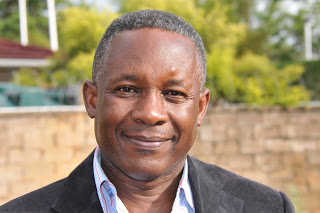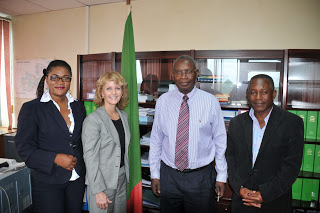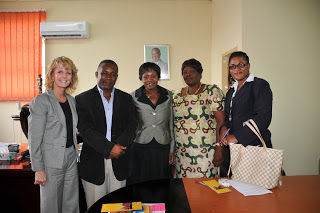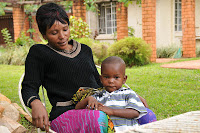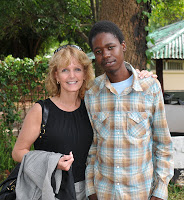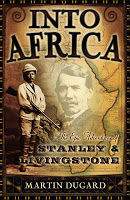Pioneers in Zambia
After this meeting, we head for the Ministry of Health. Like in Zimbabwe, we have to mount six flights of stairs. We are ushered in to meet Minister of Health Dr. Joseph Kasonde, a warm man. He listens to us share our thoughts about hemophilia, admitting “We have not paid attention to hemophilia. We’ll need to find out how many are diagnosed.” We have a thoughtful discussion, exchange cards and I present him with my book on VWD.
After we leave, we head to a shiny, big mall and have some tea. We laugh at
the slow service at Wimpy’s, despite the lack of customers, because the tall
young waiter is quite taken with the pretty young waitresses, and apparently not with us. After tea we head to the Ministry of Community Development, Mother & Child Health. These are the people in the forefront of grassroots education and outreach, something I am really intrigued with, because in Africa, we need to start empowering people at the home level. Most of them live just too far away from the hospitals. The Honorable Dorothy Kazunga welcomes us, and we’re later joined by Professor Elwyn
Chomba, Permanent Secretary. The ladies are warm, friendly, passionate. We speak about outreach, and how to identify more patients with hemophilia in Zambia. These ladies rightly know too that much of health care falls to the mother, and so empowering women is the key to success in Africa.
Soon
lunch is prepared, and some more volunteers arrive. These are trustees of the
new organization. Lunch is delicious—chicken, sausage, rice and vegetables—and we
speak a little. Still, the parents are extremely shy and reserved, so we don’t
get to share much. Afterwards, a photo session to capture our names and faces,
and then we depart. Everything is so new to the patients. I hope that in a few
years’ time, they will be the experienced parents coaching the new ones.
One happy face I meet is Fynn Machona, a handsome young man with hemophilia from Zimbabwe, who is now living with his sister in Lusaka. I met Fynn five years ago in Zimbabwe and am happy to say he looks great. He had hoped to come to Zambia to attend college, but this is not working out. He dreams of being a hematologist and working with hemophilia patients. For now, we’re glad to have him in Lusaka as he can help with the new hemophilia organization.
also retired, and has some time to devote to this new mission. Charity is also
professional, motivated by helping children, and knows how to put together a
nonprofit. The rest of the team are also professionals, and all are impacted personally
by blood disorders.
banks of the Zambezi River, reading a book about Livingstone’s adventures, I think about how brave he was—how much he sacrificed (he buried his own wife Mary along the banks of the Zambezi after she contracted malaria), suffered and persevered, for years seeking to reach his final goal, to discover the source of the Nile. I think it’s still brave to start a new journey—a hemophilia organization— in a country like Zambia, in the midst of suffering, budget shortages, with many dependent on you and looking for leadership and guidance. Even when the Royal Geographic Society covered backed Livingstone, it was still only him out in the middle of the unknown continent he so loved. Maurice and his team stand also in the middle of Africa, pioneering medical help and aid to families
with hemophilia; we can back them too, but we can also travel with them on their journey, so they will achieve their mission.
One of my favorite books.
This gripping tale recounts like a novel the story of the search for the source
of the Nile, considered in the mid-1800s to be the last great geological find.
The book picks up after Sir Richard Burton and John Hanning Speke return,
without definite proof. To put the question to rest, and to secure a financial
future for his motherless children, David Livingstone sets off one last time to
Africa in 1870 to search for it. Now in his 50s, Livingstone suffers mightily
on this journey, with infectious disease, tribal warfare, monsoons. The book is
full of suffering. Eventually, he cannot continue, and near death, awaits in a
village. Meanwhile, Henry Morton Stanley, a journalist working for the
tabloid The Herald, is secretly commissioned by the owner, bad
boy James Gordon Bennett, Jr., to find Livingstone, get the scoop of the
century, and bring him home, thus shaming even the British. The story is
riveting as the character study on what made each man tick, but especially
Stanley, an utter failure in life until this commission. He later became one of
Africa’s greatest explorers… and most reviled leader. Five/five stars.

